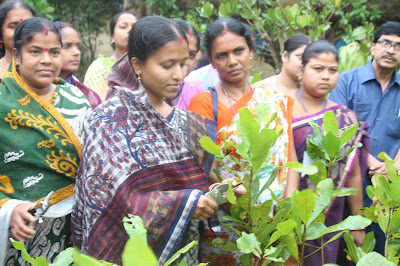 |
| Training on Softwood Grafting |
Cashew(
Anacardium occidentale), was first introduced in India from Brazil by the Portuguese during the later half of the 16th Century mainly for afforestation and soil conservation. However with due course of time, Cashew emerged as a source of foreign revenue next to tea and coffee. Apart from the kernel, juices from cashew apple and oil from its shell also have high market demand. Cashew shell oil is used in lumination, break linings, electrical installations, surface coatings, paintings etc. India is the third largest producer and exporter of Cashew nut after Vietnam and Nigeria. India produces 23 % of the total global production covering an area of 9.53 lakh hactare with a total production of 6.74 lakh tons of raw Cashew(2010-11). Out of those areas under Cashew cultivation, 70 % of the areas belongs to small and marginal land holding.
 |
| Female SHG members in front of their cashew nursery |
West Bengal with a population density of 903 persons per kilometer, its agriculture sector is dominated by small and marginal farmers comprising 95 % of the total 5.7 million farmers. Laterite morrum soil and sandy loams prevalent in western districts are found to be ideal for cashew nut cultivation. However its cultivation is carried on in some areas in Bankura, Purba Midnapore and Paschim Midnapore but yet to catch up with their potentialities. There are several reasons behind it and one most common is unavailability of appropriate propagating material. Most of the cashew nut plants grown in the area are propagated from seed and the species being highly cross pollinated exhibits wide variations in respect of nut, apple and yield of seeding progenies. Therefore, Vegetative propagation has been recommended as a solution out of which Softwood Grafting are found to be most suitable due to its possibility in producing large number of grafts in a short time.
 |
| Cashew Nut Nursery |
Anandhara program was launched in the year 2012 in West Bengal under National Rural Livelihood Mission (NRLM) with the main objective of mobilizing the rural poor and vulnerable people into self managed federated institutions and support them for livelihood collectives. To further these objectives, West Bengal State Rural Livelihood Mission(WBSRLM), a registered society under the Society Registration Act 1860 was formed by the State Govt to implement the NRLM in the state. So far 4,12,535 SHGs are registered under the program representing 41,66,605 members from all over the state. WBADMIP since its inception in the year 2012 has been providing institutional support to the Water User Associations formed to Manage, Operate and Maintain the Minor Irrigation Structures developed under the project throughout the state. The Project lately shifting its focus towards more integrated approach instead of individual schemes and under one such initiatives in Paschim Midnapore, a 350 ha of land has been brought under Watershed based concept. The project officials decided to introduce Cashew nut plantation in the wastelands of the watershed considering its suitability to the laterite and sandy loam soil predominant in the area. To ensure supply of good planting material, the Project in a convergence program with WBSRLM engaged 280 members from the women based SHGs registered under Anandhara Program to develop cashew nut nursery. For the purpose, WBADMIP has made arrangements to train the 280 female beneficiaries on cashew nut nursery management currently being undertaken by experts from State Horti Deptt at State cashew nut farm, Digha, Purba Medinipur. After the completion of the training, the SHGs from which these female beneficiaries belongs will be entrusted to produce 1 lakh quality cashew nut planting materials under a buy back agreement with WBADMIP.
With the current traditional practices of propagating from seed with unknown sources of origin gives a very low yield of less than a kilo of raw cashew nut from each tree, adopting improved practices of nursery management such as grafting and known source of origin can increase the yield to 4-5 kg/tree.




No comments:
Post a Comment